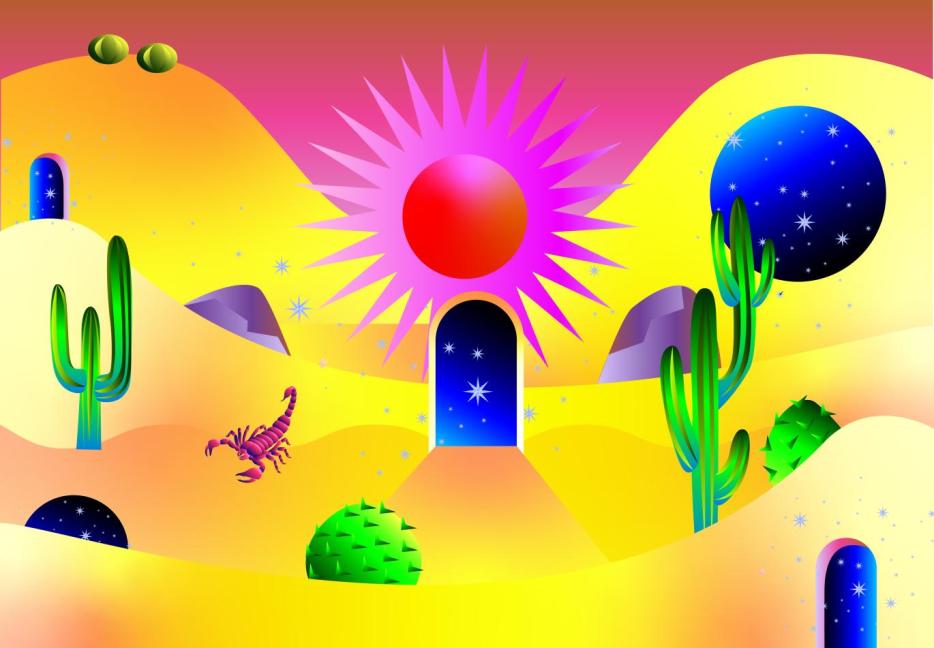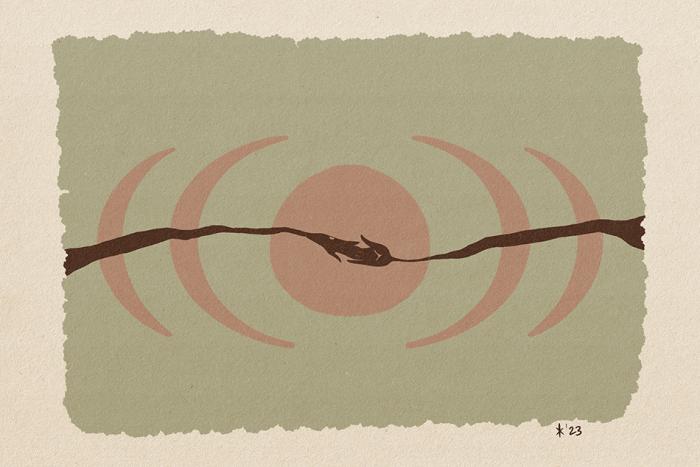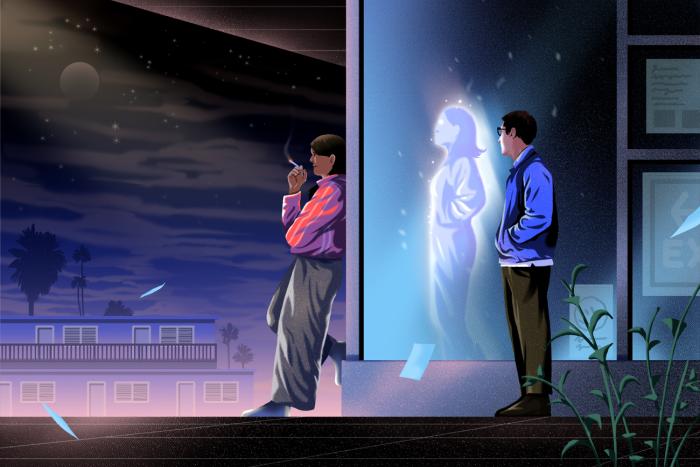Almost a year into the pandemic, the desert began to loom large in my mind. I thought about it constantly, this vague idea of southwestern American emptiness, its Joshua trees and vast stone monuments as far as the eye could see. Of course, there were limits to what I could imagine of this place I had never been. So to fill the gaps in my daydreams, I turned to the voice of the Mojave Desert, the oracle Ken Layne.
Layne is the host of a long-running, late night radio show called Desert Oracle—a weekly homage to the weirdness and wonders of the Southwest, delivered like an AM radio sermon. Towards the end of 2020, Layne turned some of his monologues and stories from the show into a book. I was easily transfixed; the Mojave’s alien landscape, its supernatural myths, its cast of dreamers, drifters, and its rich Indigenous history placed me firmly in the desert’s thrall. In Layne’s stories, the desert is resplendent with bounty, beauty—not in spite of its emptiness and desolation, but because of it. “Desert is wilderness stripped bare,” Layne writes, “and when left alone is creation in perfection.”
I suspect escapism was part of what lured me to the Southwest; to read about an environment so distant and vast, so unlike my own, was exhilarating during a time of lockdowns and anxiety. Of course, there was something more. The desert seemed to operate on entirely different rules—to exist on an entirely different geologic scale—than anything I had known before. There was slowness in the desert, if not the desert itself. This was the opposite of how I had been living my life, of how I approached my creative pursuits. But haste no longer felt right.
I was maybe six years old when I knew I wanted to be a writer. I wrote cookbooks, family camping travelogues, fan fiction, a limerick about my Nintendo. I wrote to be seen. But what sealed my fate was a slim little pamphlet about a black cat. My teacher liked it so much, she placed it on a shelf—next to the real books—for anyone to read. I waited for someone to pick it up, to hold a piece of myself in their hands. As I grew older, I came to believe that if I wrote stories good enough to read, to share, people might understand me better—that, through writing, I could make myself matter. But the problem with tying my self-worth to my work was that nothing I did ever seemed to live up to the image of myself I had in my mind. So I worked, ceaselessly, rarely saying no, until the pandemic forced me to pause, to finally ask myself why.
This is how, in December of last year, I found myself running along a six-mile trail that began, unceremoniously, at the top floor of the Hoover Dam’s multi-level parking garage—the first stop on my inevitable desert trip. From Las Vegas, my partner Danielle and I planned to drive across the Mojave to Lake Mead, Valley of Fire State Park, and Mojave National Preserve. To be in a place so seemingly timeless, I thought, might help me reevaluate the arc of my own life—the futility of the pace at which I had been working, and how it might feel if I tried to slow down. I didn’t expect enlightenment or easy epiphanies—certainly not as a visitor, seeing these places for the very first time. But I hoped I might begin to understand, as do those who know and love this place deeply, what life in the desert can mean.
The dam is a marvel, a feat, a piece of infrastructure so utterly massive that its size can be hard to grasp even when standing on its rim. It is so large that a railway had to be built specifically for its construction, a procession of metal through the Nevada dust. But nowadays, the old railway has been reclaimed and turned into a trail. Its entrance feels illicit, like a mistake; for a kilometre I ran past a cat’s cradle of electric power lines, hulking transformers, and old, retired equipment. And then a tunnel appeared, like a punch hole in the dirt. I ran towards the light, and emerged into another world.
I was stunned by how expansive it all felt—unfurling, undulating, on and on, just as I had imagined it in my mind. The mountain ranges were bathed in a salmon-coloured light, and Lake Mead glowed a cerulean blue. Patches of scrub made the surrounding playa look like it had been sprinkled with poppy seeds. My brain was like arid ground after a rainstorm, eager to absorb it all; I could not stop looking around. As I traced the path of the old railway tracks, Danielle thought I might run right off the cliffside.
A sign at the trailhead listed local flora and fauna: the beavertail cactus, with its flat, prickly paddles; the barrel cactus, round like a drum and swaddled in thorns; and, of course, the bighorn sheep, lithe and dust-toned, with their imposing corkscrew horns. For the first few kilometres, I saw nothing. But as my eyes adjusted, I started to see things I hadn’t noticed before. Cacti were suddenly everywhere—hidden, nestled, blending into the dirt. Spotting them became a game. But the bighorn sheep remained elusive. I started calling to them—at first, in jest, doing my best impression of the sheep from Babe. I bah-talked my way down the old railway trail until Danielle grabbed my arm. A whole group of bighorn sheep were descending the cliffside, picking their way through the scrub and stone. We watched in silence, for what felt like an eternity, until the bighorn realized they were not alone. They froze, stared, were gone in a flash.
*
In the desert I saw a world where qualities like “slow” and “less” were features, not bugs. Here was an environment that was not merely defined by absence, but thrived on it. I wondered if maybe, in time, I could learn to be more like the desert, too.
Mary Austin, writing in 1903, had a similar thought. In The Land of Little Rain, Austin’s vivid account of twelve years spent in the American Southwest, she paints a visceral picture of the Mojave landscape. “There are hills, rounded, blunt, burned, squeezed up out of chaos, chrome and vermilion painted, aspiring to the snow-line,” Austin writes. There is more sky, she says, than any other place in the world. But Austin also recognized that amid the harshness and aridity is an abundance of life—lizards, snakes, owls, badgers, coyotes, foxes, and rats. There are the plants that flower against all odds, so little they have to drink, and the immortal creosote, a perpetual green. “The desert flora shame us with their cheerful adaptations to the seasonal limitations,” Austin writes. “One hopes the land may breed like qualities in her human offspring, not tritely to ‘try,’ but to do.”
It may be tempting to think that solitude is what primarily draws writers to the desert—that it is a place of passive experience, a wild, windswept escape. On the contrary, I think writers like the desert because it demands our participation. The desert asks us to pay close attention, to experience it with all our senses. It asks for our deference, our respect. It is a land of close reading, and there are countless stories to be found—as the Indigenous peoples before us, and still today, have long known—but only if you know how to look, listen, feel.
Time, for instance, moves differently here—slowly, languorously, lingering, and long, “something encountered through the senses not imposed upon the mind,” Terry Tempest Williams writes. In Red, her book of essays about Utah’s red rock wilderness, the desert is precious, essential, and not to be taken for granted. Protection—from government, development, ourselves—is a recurring, insistent theme. It’s tempting to think the desert is a parcel of parched land being put to poor use. We’re quick to equate slowness with a lack of productivity. But, in fact, the desert merely has a different idea of what it means to thrive. One need barely scratch the surface of the desert literary canon, to see life in the desert in a way they had scarcely considered before. Here, “beauty is not found in the excessive,” Williams writes, “but in what is lean and spare and subtle.”
During one of our day trips, to Mojave National Preserve, Danielle and I went on a short hike to Teutonia Peak—an outcrop roughly 700 feet high, nestled among one of the densest concentrations of Joshua trees in the world. We walked past blankets of yellow tufted grass and the occasional abandoned mine shaft. Snow still clung to the cacti in clumps. The air was cool, dry, and stung to breathe. This was winter in the desert.
With Teutonia before us, we clambered up rocks and stony steps. Soon, the wind was unrelenting, and around us loomed the spectre of death; a fire here, in 2020, burned as many as 1.3 million Joshua trees black. Standing on Teutonia Peak, it looked as if a paintbrush had been dragged across the valley, marking swaths of ancient yucca for demise. I considered the age of these Joshua trees—150 years, on average—and how unlikely it was they would all grow back. It felt mournful, ominous, a portent of things to come—loss made all the more visceral by the grandeur of what lay beyond. I fixed my gaze on the distant caps of snow-dipped mountains, and the gardens of gargantuan rock that looked like pebbles from afar.
At the summit, I understood what Edward Abbey meant when he called this place a “monstrous and inhuman spectacle of rock and cloud and sky and space.” In Abbey’s Desert Solitaire—both a paean to pristine wilderness and a fierce defence of its wildness against those who sought, and continue to seek, to tame our public lands for commercial gain—the scale of it all, across space and time, is literally impossible to comprehend. Abbey felt it in the mesas that will outlast us all, and in the sky, alight and brimming with the constellations of long-dead stars—“a sense of time enough to let thought and feeling range from here to the end of the world and back.”
*
There’s a passage I think about often, in a song by Prefab Sprout. The English band had a string of hits in the 1980s—perfect gems of songwriting, many about an imagined America, a place the band would never once tour. But nothing in Prefab Sprout’s catalogue has stuck with me quite like “I Trawl the Megahertz.” Initially released in 2003 as a solo album by the band’s co-founder, singer-songwriter Paddy McAloon—such a departure it was, he feared, from previous Prefab Sprout—the title track is vivid, impressionistic, and twenty-two minutes long. The story goes that McAloon, recovering from surgery on his detached retinas, spent days in bed listening to shortwave radio. To pass the time, he recorded snippets of voices and interviews from call-in shows, and then began to assemble the fragments into a loose narrative, writing his own lyrics to fill the gap. Rather than sing the song himself, he enlisted Yvonne Connors—a stock broker from New York, theatrically trained, recommended by a friend of McAloon’s wife—who read the lyrics in a London hotel room in a single take. McAloon has called it his most personal record—and yet, unlike previous Prefab Sprout albums, McAloon’s soft, lilting voice is barely there.
“I Trawl the Megahertz” is the kind of song I can only listen to at night, and only in the dark. Spare and orchestral, the repeating motif has an undeniable twilight quality to it—poignant and bittersweet. It’s a song to get lost in, one that never fails to instill in me a sense of awe, like staring at a star-dappled sky. There’s a whistling synth, almost theremin-like in timbre, that contributes to the feeling of thrilling unease. The strings are lush and dreamlike, like being lulled into reverie. All the while, Connors paints feverish images of distant cities and fantastical scenes.
But it’s the “fancy electronic dishes” Connors invokes that stick with me most. You can find them in the Mojave, pointed at the sky, on a quiet patch of desert near a ghost mining town. Goldstone. NASA built the first of many radio telescopes here in the late 1950s to communicate with distant spacecraft, but when not in use for missions, the dishes commune with the universe itself. “They are listening for smudged echoes of the moment of creation,” says Connors; it is the phrase I cannot shake. “They are listening for the ghost of a chance. They may help us make sense of who we are and where we came from.”
When Connors speaks, I imagine driving down the dusty blacktop of a two-lane desert highway, constellations aloft, sandstone unfurling into infinity, the phase-shift of distant transmissions slipping through the ether. Off in the distance the dishes pluck signals from the skies. The messages they seek are so distant, so old, that all we can do is wait for them to arrive—a cosmic game of telephone. But the Mojave is well suited for this task. The desert is full of its own smudged echoes, whispering to us from the rock.
*
Never has a name been quite so apt as Nevada’s Valley of Fire. The sandstone here is riven with streaks and ribbons of pastel, rust, and chalk—dull pinks, reds, and oranges that glow in the noonday sun, and only grow more dramatic as the light disappears.
The park felt like a secret, hiding in plain sight. One moment, we were driving down a flat, endless road, flanked by scrub and the occasional Joshua tree. The next, we were plunging, falling, pouring into the valley. It felt like being swallowed. The road we were on unspooled like a ribbon, almost biblical in how it parted the surrounding stone.
Our hike started on a massive slab of rock, smooth and sloping, larger than anything I had ever seen—until, suddenly, it would cleave or crumble. In every direction, jagged limestone peaks pierced the bluest of blue skies. We descended—into slot canyons and sidewinder paths, past arches and crevasses and mysterious holes. Pink-hued walls loomed and towered, scratched and striated with long, ragged lines. Every fresh encounter reconfigured my idea of what stone and rock could be.
We scaled, we slid, until we reached the Fire Wave—a majestic stretch of intensely coloured rock that swoops and swirls and melts. The spectacle is, quite literally, the product of time—the mineral echoes of ancient groundwater that flowed through the sand, before the weight of centuries pressed it into stone. Rarely have I felt so disoriented, so deeply connected to the ground beneath my feet; it felt like everything flowed from where I stood. Stone turned to sand, then cacti, then trees, on and on to distant, unfathomable peaks. It felt ancient, Paleolithic—unstuck from time. I felt infinitesimally small.
Only later did I find that Terry Tempest Williams had deftly conveyed what I was struggling to put into words. There are no life hacks in the desert. You can’t ask a cactus to be more productive. Instead, there is a slowness, a life not lived by calendar or clock. It is a place of stillness, patience, where one is propelled by the body and its senses, rather than the worries and strictures of the mind. It is precisely because there is so much space that time feels open, endless—weighted with possibility. It is a vast, insistent reminder that there is no such thing as wasted time. The desert inspired Williams to let slowness seep into her life.
“I am not so easily seduced by speed as I once was,” she wrote. “To see how much I can get done in a day does not impress me anymore.” Instead, she looked to the red rock, to the slowness of erosion, and the tortoises and snakes who move deliberately in the heat as models for how one might live instead: “A rattlesnake coils, its tail shakes; the emptiness of the desert is evoked.”
*
Before we lost the afternoon light, we decided to make one more stop at a shallow outcrop in Valley of Fire called Mouse’s Tank.
The park is on the ancestral homeland of the Southern Paiute people—also known as nuwu—where Nevada, Arizona, and southern Utah now sit. Lore has it that Little Mouse was a Southern Paiute outlaw who hid from authorities within these winding walls, surviving off rainwater in natural basins, or tanks. But what draws people to Mouse’s Tank today are the ancient petroglyphs that have been etched into the canyon’s sandstone walls.
Just past the trailhead, we were greeted by another group of bighorn sheep—this time, unbothered by our presence. We watched them chew shrubbery, then followed them deeper, scanning the walls as we went. A panel of petroglyphs resolved into focus on an upturned face of rock. The wall was covered with a deep, black varnish—a mineral smear, thin as tissue, thousands of years old—and a dizzying array of etchings exposed light pink rock beneath. I saw sheep and spirals and wavy lines, left not as art but as messages, to communicate across time.
Some were maps, says Shanandoah Anderson, a cultural consultant for the tribes of the Southern Paiute, and a member of the Shivwits Band. Others were warnings, directions, and records of those who came before—akin to shorthand or sign language, but written in stone. “To us, it’s kind of like billboards,” she says, or the pages of a book. And while some of the meaning has been lost to time, certain petroglyphs can still be read. “The herds of animals you see all over the petroglyphs were talking about people,” says Anderson, their territories represented by deer or sheep. Spirals are directions, and while a zigzag could mean water, a wavy line could refer to anything that flows—the wind, a river.
The clarity of the petroglyphs was arresting, the fidelity unexpected, each message remarkably well preserved—a deliberate, purposeful decision to enshrine them in the rock. “They have a lot of power,” Anderson says; it’s a sacred place to the Southern Paiutes. “I think they knew they would always be there. It was a historical account that they wanted to preserve so that we would know who they were.”
*
On my last night in the Mojave, I asked the car to play a song, a perfect desert tune. I was chasing the sunset to Red Rock Canyon, just outside Las Vegas, and wanted music to ride off into the evening’s dying, orange light.
The song I had in mind starts with the cry of a single, mournful horn. It is both a statement and a signal for the strings to join. A minute later: the ghostly jangle of an electric guitar; an urgent harmonica, its warble sharp and piercing; a soft heartbeat of toms and delicate, lilting piano. And then, after nearly three and a half minutes, Mark Hollis finally speaks. He is ostensibly Talk Talk’s lead singer, but here, on “The Rainbow” his voice is barely present at all—soft, distant, a sonic texture unto itself, like a wisp of cloud on the darkening sky.
“The Rainbow” is, to me, a perfect example of everything that makes Talk Talk great—a defining entry in the myth of Mark Hollis, a myth defined by absence and retreat. Talk Talk emerged from the primordial soup of 1980s synthpop and was initially compared to Duran Duran. But Hollis—who was inspired by the works of non-modal jazz musicians and classical composers, as recounted in Ben Wardle’s biography A Perfect Silence—chafed against these comparisons. At the height of Talk Talk’s commercial success, he took the band in a stark new direction. Pop hooks and synths gave way to the ambient, the atmospheric, the acoustic (Hollis was, in part, inspired by the atonal works of composer Arnold Schönberg, which Edward Abbey said reminded him of “the apartness, the otherness, the strangeness of the desert”). Hollis' voice, once front and centre, began to fade into the background. He receded from the public eye, too. The resulting albums—1988’s Spirit of Eden and 1991’s Laughing Stock—are spare, meditative, and easily Talk Talk’s best. Like the desert through which I was driving, they are defined by what’s missing as much as what’s there.
What Hollis valued, above all else, was silence. He understood its power and used it as a tool. “I would rather hear one note than I would two, and I would rather hear nothing than I would one note,” he once said. Space was key. “It helps to build and resolve the tensions,” Hollis said. “Silence is the most powerful instrument I have.” I find comfort in this when I worry I’m not doing enough. There’s meaning in absence, a purpose to stillness, value in what’s unseen, unsaid.
As a writer, it took me a long time to figure this out. But I’m learning. I’m trying to be more patient, to let the work take as long as it needs. “We do not trust slowness, silence, or stillness,” Williams writes in her ode to desert time. But time not spent doing the work is still a part of the work. Just as I saw in Valley of Fire, the process is the point.
I took the long, winding road into Red Rock Canyon, as darkness began its descent; parked, disembarked, sat on a low stone wall. Cactus and yucca stood before me, like expectant, royal subjects. Clouds hugged the mountaintops, fell around them like a shroud. Danielle and I watched the sun sink, then slip behind the peaks. For a long time we didn’t move. We sat in the silence, let the cold creep into our boots, and waited for nothing—for everything—to happen.






